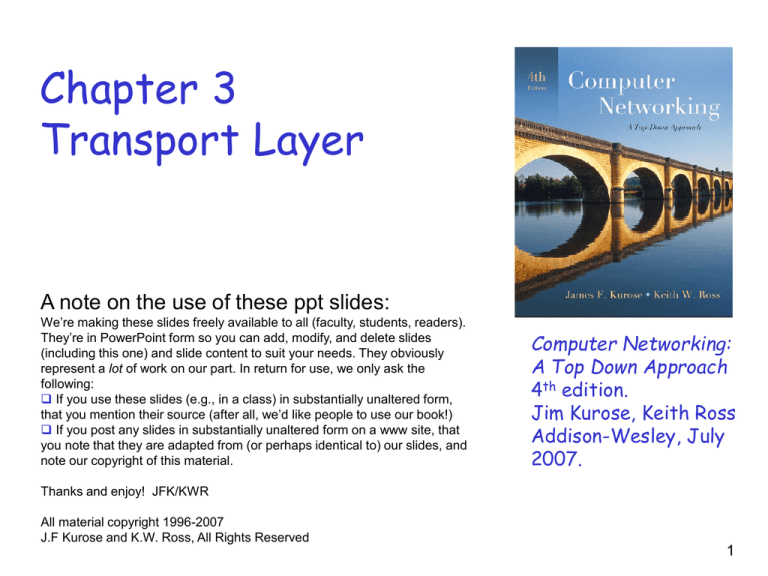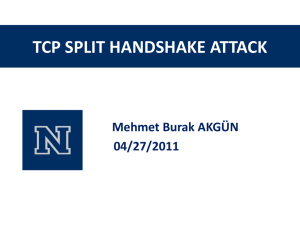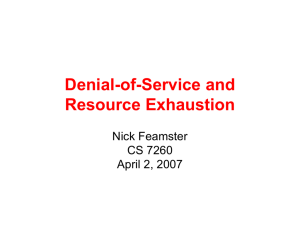
Chapter 3
Transport Layer
A note on the use of these ppt slides:
We’re making these slides freely available to all (faculty, students, readers).
They’re in PowerPoint form so you can add, modify, and delete slides
(including this one) and slide content to suit your needs. They obviously
represent a lot of work on our part. In return for use, we only ask the
following:
If you use these slides (e.g., in a class) in substantially unaltered form,
that you mention their source (after all, we’d like people to use our book!)
If you post any slides in substantially unaltered form on a www site, that
you note that they are adapted from (or perhaps identical to) our slides, and
note our copyright of this material.
Computer Networking:
A Top Down Approach
4th edition.
Jim Kurose, Keith Ross
Addison-Wesley, July
2007.
Thanks and enjoy! JFK/KWR
All material copyright 1996-2007
J.F Kurose and K.W. Ross, All Rights Reserved
1
Chapter 3 outline
3.1 Transport-layer
services
3.2 Multiplexing and
demultiplexing
3.3 Connectionless
transport: UDP
3.4 Principles of
reliable data transfer
3.5 Connection-oriented
transport: TCP
segment structure
reliable data transfer
flow control
connection management
3.6 Principles of
congestion control
3.7 TCP congestion
control
2
TCP Connection Establishment
Three-way handshake
Step 1: client host sends TCP
SYN segment to server
specifies initial seq #
no data
Step 2: server host receives
SYN, replies with SYN+ACK
segment
server allocates buffers
specifies server initial seq.
#
Step 3: client receives SYN+ACK,
replies with ACK segment,
which may contain data
aida.poly.edu
mng.poly.edu
SYN (Seq
No = x)
ckNo = x + 1 )
A
,
y
=
o
N
q
e
SYN (S
(SeqNo = x
+1, AckNo
=y+1)
3
TCP segment structure
32 bits
URG: urgent data
(generally not used)
ACK: ACK #
valid
PSH: push data now
RST, SYN, FIN:
connection estab
(setup, teardown
commands)
Internet
checksum
(as in UDP)
source port #
dest port #
sequence number
acknowledgement number
head not
UA P R S F
len used
checksum
Receive window
Urg data pnter
Options (variable length)
counting
by bytes
of data
(not segments!)
# bytes
rcvr willing
to accept
application
data
(variable length)
4
TCP Connection Termination
Step 1: client end system sends
TCP FIN control segment to
server
client
server
close
Step 2: server receives FIN,
replies with ACK.
When server is done sending all
data, it closes connection by
sending FIN.
replies with ACK.
Enters “timed wait” - will
respond with ACK to
received FINs
Step 4: server, receives ACK.
timed wait
Step 3: client receives FIN,
close
closed
Connection closed.
5
TCP Connection Management (cont)
aida.poly.edu
mng.poly.edu
SYN (Seq
No = x)
SYN (SeqNo =
y, AckNo = x
(SeqNo = x+
1, AckNo =
TCP server
lifecycle
+1)
y+1)
FIN
SYN
SYN + ACK
ACK
client
close
server
TCP client
lifecycle
timed
wait
close
closed
6
TCP state-transition diagram
CLOSED
Active open/SYN
Passive open
Close
Close
LISTEN
SYN_RCVD
SYN/SYN + ACK
Send/SYN
SYN/SYN + ACK
ACK
Close/FIN
SYN_SENT
SYN + ACK/ACK
ESTABLISHED
Close/FIN
FIN/ACK
FIN_WAIT_1
CLOSE_WAIT
FIN/ACK
ACK
Close/FIN
FIN_WAIT_2
CLOSING
FIN/ACK
ACK Timeout after two
segment lifetimes
TIME_WAIT
LAST_ACK
ACK
CLOSED
7
Chapter 3 outline
3.1 Transport-layer
services
3.2 Multiplexing and
demultiplexing
3.3 Connectionless
transport: UDP
3.4 Principles of
reliable data transfer
3.5 Connection-oriented
transport: TCP
segment structure
reliable data transfer
flow control
connection management
3.6 Principles of
congestion control
3.7 TCP congestion
control
8
Principles of Congestion Control
Congestion:
informally: “too many sources sending too much
data too fast for network to handle”
the load on the network is more than its capacity
different from flow control!
manifestations:
lost packets (buffer overflow at routers)
long delays (queueing in router buffers)
a top-10 problem!
9
Network Performance
9/13/05
10
Approaches towards congestion control
Two broad approaches towards congestion control:
End-end congestion
control:
no explicit feedback from
network
congestion inferred from
end-system observed loss,
delay
approach taken by TCP
Network-assisted
congestion control:
routers provide feedback
to end systems
single bit indicating
congestion
explicit rate sender
should send at
11
Network-Assisted Congestion Control
12
TCP Congestion Control
Approach
Limit the rate at which sender sends data as a
function of perceived congestion in the network
Issues
How does it perceive that there is congestion in
the network?
What algorithm does it use to change the
sending rate as a function of the perceived
level of congestion?
13






